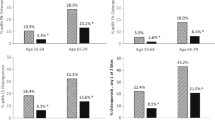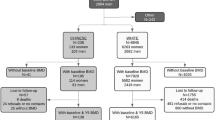Abstract
Introduction
While osteoporosis is common among women of Chinese descent, a readily available bone mineral density (BMD) referent database for Chinese American women does not exist. Fracture risk among this population is currently assessed using a Caucasian reference as well as diagnostic criteria for osteoporosis developed for postmenopausal Caucasian women. Many studies indicate that there are important racial differences in skeletal health and fracture risk, an observation that makes the application of Caucasian data to all groups problematical. This study was undertaken to establish a BMD referent database in Chinese American women and to compare it with a Caucasian female database. It is expected that a race-specific database will be useful in the assessment of bone health for Chinese American women.
Methods
Healthy Chinese American women (n=359), ages 20–90, were recruited. Along with dual-energy X-ray absorptiometry (DXA) of the total hip and lumbar spine, demographic, medical, familial, nutritional, and behavioral data were obtained. The mean and standard deviation for BMD at each site was calculated for each 10-year age group and compared to mean BMD values for Caucasian women supplied as found in the Hologic DXA instrument. Osteoporosis diagnosis rates for this cohort, calculated with the Caucasian and newly established Chinese American BMD referent values, were compared with each other.
Results
Compared with Caucasian women, Chinese American women have significantly lower BMD at the lumbar spine, total hip, and femoral neck across a wide spectrum of age groups. As a consequence, more than one-half of Chinese American women ≥50 years of age, who would be characterized as osteoporotic using a Caucasian referent, would not be diagnosed as such if a Chinese American referent were utilized.
Conclusion
Chinese American reference BMD values are significantly lower than those for Caucasian women. Future studies relating Chinese American BMD values to fracture risk are necessary in order to determine if ethnic database-derived T-scores would be more predictive of fracture risk and to develop meaningful diagnostic criteria for this population.



Similar content being viewed by others
References
NIH Consensus Development Panel on Osteoporosis (2001) Osteoporosis prevention, diagnosis and therapy. JAMA 285:785–795
Cummings SR, Nevitt, MC, Browner, WS, Stone, K, Fox, KM, Ensrud, KE, Cauley, J, Black, D, Vogt, TM (1995) Risk factors for hip fracture in white women. Study of Osteoporotic Fractures Research Group. N Engl J Med 332:767–773
Forsen L, Sogaard AJ, Meyer HE, Edna T, Kopjar B (1999) Survival after hip fracture: short- and long-term excess mortality according to age and gender. Osteoporos Int 10:73–78
Hannan EL, Magaziner J, Wang JJ, Eastwood EA, Silberzweig SB, Gilbert M, Morrison RS, McLaughlin MA, Orosz GM, Siu AL (2001) Mortality and locomotion 6 months after hospitalization for hip fracture: risk factors and risk-adjusted hospital outcomes. JAMA 285:2736–2742
Katelaris AG, Cumming RG (1996) Health status before and mortality after hip fracture. Am J Public Health 86:557–560
Riggs BL, Melton LJ 3rd (1995) The worldwide problem of osteoporosis: insights afforded by epidemiology. Bone 17:505S–511S
Liu Z, Piao J, Pang L, Qing X, Nan S, Pan Z, Guo Y, Wang X, Li F, Liu J, Cheng X (2002) The diagnostic criteria for primary osteoporosis and the incidence of osteoporosis in China. J Bone Miner Metab 20:181–189
Barnes J, Bennett CE (2002) The Asian population:2000. United States Census 2000 Brief
Day JC (2001) National Population Projections. In: US Census Bureau. http://www.census.gov/population//www/pop-profile/natproj.html
Binkley NC, Schmeer P, Wasnich RD, Lenchik L (2002) What are the criteria by which a densitometric diagnosis of osteoporosis can be made in males and non-Caucasians? J Clin Densitom 5[Suppl]S19–S27
Cummings SR, Bates D, Black DM (2002) Clinical use of bone densitometry: scientific review. JAMA 288:1889–1897
Melton LJ 3rd (2001) The prevalence of osteoporosis: gender and racial comparison. Calcif Tissue Int 69:179–181
Miller PD (2003) Bone mineral density-clinical use and application. Endocrinol Metab Clin N Am 32:159–179, vii
Woo J, Li M, Lau E (2001) Population bone mineral density measurements for Chinese women and men in Hong Kong. Osteoporos Int 12:289–295
Wu XP, Liao EY, Huang G, Dai RC, Zhang H (2003) A comparison study of the reference curves of bone mineral density at different skeletal sites in native Chinese, Japanese, and American Caucasian women. Calcif Tissue Int 73:122–132
Xiaoge D, Eryuan L, Xianping W, Zhiguang Z, Gan H, Zaijing J, Xiaoli P, Hongzhuan T, Hanwen W (2000) Bone mineral density differences at the femoral neck and Ward’s triangle: a comparison study on the reference data between Chinese and Caucasian women. Calcif Tissue Int 67:195–198
Lauderdale DS, Jacobsen SJ, Furner SE, Levy PS, Brody JA, Goldberg J (1997) Hip fracture incidence among elderly Asian-American populations. Am J Epidemiol 146:502–509
Silverman SL, Madison RE (1988) Decreased incidence of hip fracture in Hispanics, Asians, and blacks: California hospital discharge data. Am J Public Health 78:1482–1483
Xu L, Lu A, Zhao X, Chen X, Cummings SR (1996) Very low rates of hip fracture in Beijing, People’s Republic of China the Beijing Osteoporosis Project. Am J Epidemiol 144:901–907
Ling X, Cummings SR, Mingwei Q, Xihe Z, Xioashu C, Nevitt M, Stone K (2000) Vertebral fractures in Beijing, China: the Beijing osteoporosis project. J Bone Miner Res 15:2019–2025
Kanis JA, Melton LJ 3rd, Christiansen C, Johnston CC, Khaltaev N (1994) The diagnosis of osteoporosis. J Bone Miner Res 9:1137–1141
Koh SK, Cho SH, Hwang YY, Moon H, Kim DS, Cho JL, Cho SS (1992) Spinal bone mineral density of normal and osteoporotic women in Korea. J Korean Med Sci 7:136–140
Kin K, Lee JH, Kushida K, Sartoris DJ, Ohmura A, Clopton PL, Inoue T (1993) Bone density and body composition on the Pacific rim: a comparison between Japan-born and U.S.-born Japanese-American women. J Bone Miner Res 8:861–869
Berenson AB, Breitkopf CR, Grady JJ, Rickert VI, Thomas A (2004) Effects of hormonal contraception on bone mineral density after 24 months of use. Obstet Gynecol 103:899–906
Chi I, Pun KK (1991) Dietary calcium intake and other risk factors: study of the fractured patients in Hong Kong. J Nutr Elder 10:73–87
Paffenbarger RS Jr, Hyde RT, Wing AL, Hsieh CC (1986) Physical activity, all-cause mortality, and longevity of college alumni. N Engl J Med 314:605–613
Paffenbarger RS Jr, Wing AL, Hyde RT (1978) Physical activity as an index of heart attack risk in college alumni. Am J Epidemiol 108:161–175
Bonnick SL, Johnston CC Jr, Kleerekoper M, Lindsay R, Miller P, Sherwood L, Siris E (2001) Importance of precision in bone density measurements. J Clin Densitom 4:105–110
Akaike H (1981) Likelihood of a model and information criteria. J Econom 16:3–14
Kelly T (1996) Developing DXA Reference Databases. In: Hologic, Inc. (unpublished work; available upon request form Hologic, Waltham, Mass.)
Cundy T, Cornish J, Evans MC, Gamble G, Stapleton J, Reid IR (1995) Sources of interracial variation in bone mineral density. J Bone Miner Res 10:368–373
Finkelstein JS, Lee ML, Sowers M, Ettinger B, Neer RM, Kelsey JL, Cauley JA, Huang MH, Greendale GA (2002) Ethnic variation in bone density in premenopausal and early perimenopausal women: effects of anthropometric and lifestyle factors. J Clin Endocrinol Metab 87:3057–3067
Russell-Aulet M, Wang J, Thornton JC, Colt EW, Pierson RN Jr (1993) Bone mineral density and mass in a cross-sectional study of white and Asian women. J Bone Miner Res 8:575–582
Bhudhikanok GS, Wang MC, Eckert K, Matkin C, Marcus R, Bachrach LK (1996) Differences in bone mineral in young Asian and Caucasian Americans may reflect differences in bone size. J Bone Miner Res 11:1545–1556
Lau EM, Lynn H, Woo J, Melton LJ 3rd (2003) Areal and volumetric bone density in Hong Kong Chinese: a comparison with Caucasians living in the United States. Osteoporos Int 14:583–588
Seeman E (2001) Clinical review 137: sexual dimorphism in skeletal size, density, and strength. J Clin Endocrinol Metab 86:4576–4584
Turner CH, Burr DB (1993) Basic biomechanical measurements of bone: a tutorial. Bone 14:595–608
Cummings SR, Cauley JA, Palermo L, Ross PD, Wasnich RD, Black D, Faulkner KG (1994) Racial differences in hip axis lengths might explain racial differences in rates of hip fracture. Study of Osteoporotic Fractures Research Group. Osteoporos Int 4:226–229
Faulkner KG, Cummings SR, Black D, Palermo L, Gluer CC, Genant HK (1993) Simple measurement of femoral geometry predicts hip fracture: the study of osteoporotic fractures. J Bone Miner Res 8:1211–1217
Davis JW, Nevitt MC, Wasnich RD, Ross PD (1999) A cross-cultural comparison of neuromuscular performance, functional status, and falls between Japanese and white women. J Gerontol A Biol Sci Med Sci 54:M288–M292
Lau EM, Suriwongpaisal P, Lee JK, Das De S, Festin MR, Saw SM, Khir A, Torralba T, Sham A, Sambrook P (2001) Risk factors for hip fracture in Asian men and women: the Asian osteoporosis study. J Bone Miner Res 16:572–580
Finkelstein JS, Sowers M, Greendale GA, Lee ML, Neer RM, Cauley JA, Ettinger B (2002) Ethnic variation in bone turnover in pre- and early perimenopausal women: effects of anthropometric and lifestyle factors. J Clin Endocrinol Metab 87:3051–3056
Acknowledgements
This investigation was supported in part by: NIDDK T32 DK07271, the Endocrine Fellows Foundation, the Merck Medical School Grant Progam, Procter & Gamble Pharmaceuticals, and the Chinese American Medical Society-Chinese American Independent Physicians Association (CAMS-CAIPA) Community Service Fund
Author information
Authors and Affiliations
Corresponding author
Rights and permissions
About this article
Cite this article
Donovan Walker, M., Babbar, R., Opotowsky, A.R. et al. A referent bone mineral density database for Chinese American women. Osteoporos Int 17, 878–887 (2006). https://doi.org/10.1007/s00198-005-0059-9
Received:
Accepted:
Published:
Issue Date:
DOI: https://doi.org/10.1007/s00198-005-0059-9




